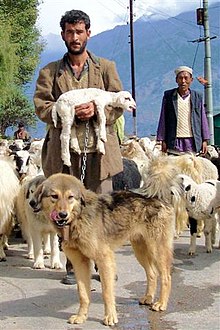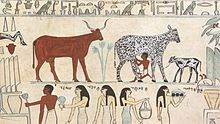驯化
驯化是指一種生物的成長與生殖逐漸受另一種生物利用與掌控的過程,例如人類栽培各種農作物、畜牧,以及切葉蟻馴養真菌。人類驯化动植物的目的主要包括作為食物和衣物的來源、運輸、守衛或是觀賞娛樂用途。驯化被认为是人类文明起源的里程碑事件[1],自进入全新世后总共约有2500个物种受到过人类驯化, 约250个物种被认为进行了完全驯化[1]。

人类驯化植物至少在1万2千年前就开始了,例如谷物和葫芦,独立的动植物驯化事件至少发生在美洲、西南亚、南亚、东亚等11个地区[2]。人类最早的农耕文明美索不达米亚文明在距今至少一万年前就种植了豌豆、亚麻、鹰嘴豆、小麦和大麦等;中国独立驯化了猪、黍、粟、大豆和稻米等[3]。人类驯养的常見動物包括了提供物质价值的家畜、家禽和养殖水产,以及提供情感价值的寵物和观赏鱼。最先被人类驯化的动物是由灰狼演化出的狗,在新石器革命后在美索不达米亚驯化的山羊、绵羊、家牛等传播到了各个大洲[4];南美大陆的美洲驼和羊驼被驯化用于肉食、驼役和生产驼毛制品[5]。
动物编辑
起源编辑

末次盛冰期结束后大规模的动物驯化在全新世爆发,推动了人类社会在新石器时代的快速发展[6]。除了最早被人类驯化的动物狗(由灰狼(Canis lupus)驯化[7])外,其他驯化动物都是伴随着农业文明的发展逐渐驯化[2]。
动物驯化形成了一种长期的互惠关系:驯化者为被驯化动物提供庇护, 被驯化动物为驯化者提供稳定的产品和便利, 驯化双方在整个过程中都增加了生存适应性[8]。驯化后的动物为人类提供了肉食、服饰和生产力等[2]。
动物能否被成功驯化虽然环境是重要条件,但动物本身的特性更为重要(例如近东地区的瞪羚和非洲的斑马就因为动物本身的特性不适合驯化,而至今未能驯化成功)[9]。总体而言,能成功驯化的动物仍然是少数[10]。
普遍认为,适合驯养的动物应具有以下特点[2]:
| 物种 | 野生祖先 | 年代 | 地区 |
|---|---|---|---|
| 狗 (Canis lupus familiaris) | 公元前15000年 [11] | 东亚和非洲 | |
| 绵羊 (Ovis orientalis aries) | 亚洲盘羊(O. orientalis) | 公元前9000-11000年[12][13] | 西南亚 |
| 山羊 (Capra aegagrus hircus) | 野山羊(C. aegagrus) | 公元前10000年 [14] | 伊朗 |
| 猪 (Sus scrofa domestica) | 欧亚野猪(S. scrofa) | 公元前9000年[15] | 近东、中国 |
| 牛 (Bos primigenius taurus) | 公元前8000年[16][17] | 印度、中东和撒哈拉以南非洲 | |
| 猫 (Felis catus) | 公元前7500年 [18][19][20][21][22] | 塞浦路斯和近东 | |
| 鸡 (Gallus gallus domesticus) | 红原鸡(G. gallus) | 公元前6000年[23] | 印度和东南亚 |
| 豚鼠 (Cavia porcellus) | 公元前5000年[24] | 秘鲁 | |
| 驴 (Equus africanus asinus) | 非洲野驴(E. africanus) | 公元前5000年[25][26] | 埃及 |
| 家鸭 (Anas platyrhynchos domesticus) | 绿头鸭(A. platyrhynchos) | 公元前4000年 | 中国 |
| 水牛 (Bubalus bubalis) | 野水牛(B. arnee) | 公元前4000年 | 印度, 中国 |
| 马 (Equus ferus caballus) | 野马(E. ferus) | 公元前4000年[27] | 欧亚草原 |
| 單峰駱駝 (Camelus dromedarius) | 公元前4000年 | 阿拉伯 | |
| 大羊駝 (Lama glama) | 原驼(L. guanicoe) | 公元前3500年 | 秘鲁 |
| 蚕 (Bombyx mori) | 公元前3000年 | 中国,参见:蠶業。 | |
| 驯鹿 (Rangifer tarandus) | 公元前3000年[28] | 俄罗斯 | |
| 野鸽 (Columba livia) | 公元前3000年 | 地中海盘地 | |
| 鵝 (Anser anser domesticus) | 公元前3000年[29] | 埃及 | |
| 双峰骆驼 (Camelus bactrianus) | 公元前2500年 | 中亚 | |
| 牦牛 (Bos grunniens) | 公元前2500年 | 中国西藏 | |
| 爪哇野牛 (Bos javanicus) | 未知 | 东南亚、爪哇岛 | |
| 大额牛 (Bos gaurus frontalis) | 未知 | 东南亚 | |
| 羊驼 (Vicugna pacos) | 原驼(L. guanicoe) | 公元前1500年 | 秘鲁 |
| 雪貂 (Mustela putorius furo) | 公元前1500年- | 欧洲 | |
| 番鸭 (Cairina momelanotus) | 未知 | 南美洲 | |
| 珍珠鸡 | 未知 | 非洲 | |
| 鲤鱼 | 未知 | 东亚 | |
| 家养火鸡 | 公元前500年 | 墨西哥 | |
| 金鱼 | 未知 | 中国 | |
| 穴兔 | 公元前1600年 | 欧洲 | |
| 瘤牛 (Bos primigenius indicus) | 原牛印度亚种 | 公元前8000年 | 印度 |
| 蜜蜂 | 公元前4000年 | 多个地区,参见:蜜蜂養殖。 |
驯化的方式编辑
人类最初因喜爱动物而对其进行饲养并建立了亲密关系[2]。如今广为接受的驯化方式是共生、猎食和定向[30]。在共生方式中,野生动物被食物残渣、污秽物吸引,主动接近人类并逐渐与人类建立了双向的伙伴关系,例如最早被驯化的狗;在捕猎方式中,人类初期直接杀死捕获的野生动物,而后人们选择相对温顺的动物进行繁殖,例如猪的驯化;定向方式是在人们已经掌握了一定驯化经验之后,具有明确目的的驯化,例如马、骆驼等[2]。
扩散及育种编辑
驯化的动物随着人类的战争、迁徙、人口扩张等逐步扩散到世界各地[2]。在此过程中,驯化的动物经历了种群内近交、基因漂变、优势性状自然选择、选择松弛以及人工选育5个阶段[6]。现代随着基因组技术的发展, 大大缩短了驯化动物杂交育种的时间[31]。
现代驯化的实例编辑
| 物种 | 年代 | 地区 |
|---|---|---|
| 大鼠 | 1800s | 英国 |
| 狐狸 | 1800s | 欧洲 |
| 水貂 | 1800s | 欧洲 |
| 虎皮鸚鵡 | 1850s | 欧洲 |
| 雞尾鸚鵡 | 1870s | 欧洲 |
| 斑胸草雀 | 1900s | 澳大利亚 |
| 仓鼠 | 1930s | 美国 |
| 银狐 | 1950s | 苏联 |
| 麝牛 | 1960s | 美国 |
| 粟米蛇 | 1960s | 美国 |
| 球蟒 | 1960s | |
| 马达加斯加蟑螂 | 1960s | |
| 马鹿 | 1970s | 新西兰 |
| 刺猬 | 1980s | 美国 |
| 蜜袋鼯 | 1980s | 澳大利亚 |
| 臭鼬 | 1980s | 美国 |
| 蜜熊 | 年代不确定 | 中美洲 |
| 部分寄生蜂 | 年代不确定 |
植物编辑
最初的动物驯化影响最大的是控制动物行为的基因,而最初的植物驯化影响的是控制植物形态的基因(种子大小、植物结构、传播机制)以及生理机能(发芽或成熟的时间)。[32][33]

其他编辑
用來釀酒的酵母菌和食用真菌等等也是人類馴化後的結果。
參見编辑
- 育種
- 人工选择
- 驯化动物列表
参考文献编辑
- ^ 1.0 1.1 Meyer, Rachel S.; Purugganan, Michael D. Evolution of crop species: genetics of domestication and diversification. Nature Reviews Genetics. 2013-12, 14 (12): 840–852. doi:10.1038/nrg3605.
- ^ 2.0 2.1 2.2 2.3 2.4 2.5 2.6 Cai, Xinyu; Mao, Xiaowei; Zhao, Yiqiang. Methods and research progress on the origin of animal domestication. Biodiversity Science. 2022-04-20, 30 (4): 21457. doi:10.17520/biods.2021457.
- ^ Larson, Greger; Piperno, Dolores R.; Allaby, Robin G.; Purugganan, Michael D.; Andersson, Leif; Arroyo-Kalin, Manuel; Barton, Loukas; Climer Vigueira, Cynthia; Denham, Tim; Dobney, Keith; Doust, Andrew N.; Gepts, Paul; Gilbert, M. Thomas P.; Gremillion, Kristen J.; Lucas, Leilani; Lukens, Lewis; Marshall, Fiona B.; Olsen, Kenneth M.; Pires, J. Chris; Richerson, Peter J.; Rubio de Casas, Rafael; Sanjur, Oris I.; Thomas, Mark G.; Fuller, Dorian Q. Current perspectives and the future of domestication studies. Proceedings of the National Academy of Sciences. 2014-04-29, 111 (17): 6139–6146. doi:10.1073/pnas.1323964111.
- ^ Brown, Terence A.; Jones, Martin K.; Powell, Wayne; Allaby, Robin G. The complex origins of domesticated crops in the Fertile Crescent. Trends in Ecology & Evolution. 2009-02, 24 (2): 103–109. doi:10.1016/j.tree.2008.09.008.
- ^ Wing, Elizabeth S. Animal Domestication in the Andes. Advances in Andean Archaeology. 1978-12-31: 167–188. doi:10.1515/9783110810011.167.
- ^ 6.0 6.1 Teletchea, Fabrice. Animal Domestication: A Brief Overview. Animal Domestication. 2019-07-17. doi:10.5772/intechopen.86783.
- ^ Boyko, AR; Boyko, RH; Boyko, CM; Parker, HG; Castelhano, M; Corey, L; Degenhardt, JD; Auton, A; Hedimbi, M; Kityo, R; Ostrander, EA; Schoenebeck, J; Todhunter, RJ; Jones, P; Bustamante, CD. Complex population structure in African village dogs and its implications for inferring dog domestication history.. Proceedings of the National Academy of Sciences of the United States of America. 2009-08-18, 106 (33): 13903–8. PMID 19666600. doi:10.1073/pnas.0902129106.
- ^ Zeder, Melinda A. Core questions in domestication research. Proceedings of the National Academy of Sciences. 2015-03-17, 112 (11): 3191–3198. doi:10.1073/pnas.1501711112.
- ^ Diamond, Jared. Evolution, consequences and future of plant and animal domestication. Nature. 2002-08, 418 (6898): 700–707. doi:10.1038/nature01019.
- ^ Losey, Robert J. Domestication is not an ancient moment of selection for prosociality: Insights from dogs and modern humans. Journal of Social Archaeology. 2022-06, 22 (2): 131–148. doi:10.1177/14696053211055475.
- ^ See Origin of the domestic dog
- ^ Krebs, Robert E. & Carolyn A. Groundbreaking Scientific Experiments, Inventions & Discoveries of the Ancient World. Westport, CT: Greenwood Press. 2003. ISBN 0-313-31342-3.
- ^ Simmons, Paula; Carol Ekarius. Storey's Guide to Raising Sheep. North Adams, MA: Storey Publishing LLC. 2001. ISBN 978-1-58017-262-2.
- ^ Melinda A. Zeder, Goat busters track domestication (页面存档备份,存于互联网档案馆) (Physiologic changes and evolution of goats into a domesticated animal), April 2000, (英文).
- ^ Giuffra E, Kijas JM, Amarger V, Carlborg O, Jeon JT, Andersson L. The origin of the domestic pig: independent domestication and subsequent introgression., April 2000, (英文).
- ^ Late Neolithic megalithic structures at Nabta Playa (Sahara), southwestern Egypt. 互联网档案馆的存檔,存档日期2008-02-13.
- ^ Source : Laboratoire de Préhistoire etProtohistoire de l'Ouest de la France 存档副本. [2009-04-17]. (原始内容存档于2009-06-26)., (法文).
- ^ Oldest Known Pet Cat? 9500-Year-Old Burial Found on Cyprus. National Geographic News. 2004-04-08 [2007-03-06]. (原始内容存档于2015-11-27).
- ^ Muir, Hazel. Ancient remains could be oldest pet cat. New Scientist. 2004-04-08 [2007-11-23]. (原始内容存档于2014-10-16).
- ^ Walton, Marsha. Ancient burial looks like human and pet cat. CNN. April 9, 2004 [2007-11-23]. (原始内容存档于2007-12-22).
- ^ [1] (页面存档备份,存于互联网档案馆), domestication of the cat on Cyprus, National Geographic.
- ^ Feline genetics help pinpoint first-ever domestication of cats, MU study finds // Show Me Mizzou // University of Missouri. showme.missouri.edu. [2023-01-03]. (原始内容存档于2023-01-03) (美国英语).
- ^ West B. and Zhou, B-X., Did chickens go north? New evidence for domestication, World’s Poultry ScienceJournal, 45, 205-218, 1989, quotationPDF (26.3 KiB), 8 p. (英文).
- ^ History of the Guinea Pig (Cavia porcellus) in South America, a summary of the current state of knowledge. [2010-05-27]. (原始内容存档于2011-10-09).
- ^ Beja-Pereira, Albano et al., African Origins of the Domestic Donkey, Science 304:1781, 18 June 2004, cited in New Scientist (页面存档备份,存于互联网档案馆), (英文).
- ^ Roger Blench, The history and spread of donkeys in AfricaPDF (235 KiB) (英文).
- ^ The Domestication of the Horse 互联网档案馆的存檔,存档日期2007-02-02.; see also Domestication of the horse
- ^ Domestication of Reindeer 互联网档案馆的存檔,存档日期2009-03-16.
- ^ Geese: the underestimated species. [2010-05-27]. (原始内容存档于2017-07-27).
- ^ Zeder, Melinda A. The Domestication of Animals. Journal of Anthropological Research. 2012-06, 68 (2): 161–190. doi:10.3998/jar.0521004.0068.201.
- ^ Bosse, Mirte. A Genomics Perspective on Pig Domestication. Animal Domestication. 2019-07-17. doi:10.5772/intechopen.82646.
- ^ Zeder MA. The domestication of animals. Journal of Anthropological Research. 2012, 68 (2): 161–190. doi:10.3998/jar.0521004.0068.201.
- ^ Zeder MA. 2006. Archaeological approaches to documenting animal domestication. In Documenting Domestication:New Genetic and Archaeological Paradigms, ed. M Zeder, DG Bradley, E Emshwiller, BD Smith, pp. 209–27. Berkeley: Univ. Calif. Press
外部連結编辑
- Discussion of animal domestication (页面存档备份,存于互联网档案馆)
- Guns, Germs and Steel by Jared Diamond (ISBN 0-393-03891-2)
- News story about an early domesticated cat find
- Belyaev experiment (页面存档备份,存于互联网档案馆) with the domestic fox
- Use of Domestic Animals in Zoo Education (页面存档备份,存于互联网档案馆)
- The Initial Domestication of Cucurbita pepo in the Americas 10,000 Years Ago (页面存档备份,存于互联网档案馆)
- Phytolith evidence for early Holocene Cucurbita domestication in southwest Ecuador
- An Asian origin for a 10,000-year-old domesticated plant in the Americas